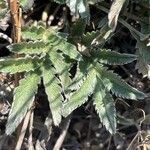Stems (0.3–)2–4(–5) dm, lengths (1–)2–4 times basal leaves. Basal leaves pinnate to subpinnate, (3–)5–15(–25) cm; petiole 1–10(–15) cm, long hairs abundant to dense, tightly appressed, 1–2.5 mm, stiff, short hairs absent or obscured, crisped-cottony hairs absent or sparse to common, glands absent or obscured; leaflets not conduplicate, lateral ones evenly (to unevenly in argyrea phase) paired, (2–)3–6(–7) per side on distal (1/6–)1/5–1/2 of leaf axis, distal pairs ± decurrent, often confluent with terminal leaflet, larger leaflets oblanceolate or narrowly obovate to oblong, 1–5(–6) × 0.3–1.5 cm, distal (2/3–)3/4 to whole margin incised 1/2 or less (rarely more) to midvein, teeth (5–)7–12(–18) per side, 1–4 mm, surfaces ± to strongly dissimilar, abaxial white, long hairs abundant (mostly on, but not limited to, veins), 1–2 mm, stiff, short hairs absent or obscured, crisped-cottony hairs abundant to dense, glands absent or obscured, adaxial green to grayish, long hairs sparse to common, rarely absent, short or crisped to, sometimes, cottony hairs absent or sparse to common, glands sparse. Cauline leaves 1–2(–3). Inflorescences 10–30-flowered. Pedicels 0.3–3(–5) cm. Flowers: epicalyx bractlets narrowly elliptic to lanceolate, rarely linear, 2–5 × 0.5–1.5 mm, (1/2–)2/3 as long as sepals, abaxial vestiture similar to or ± sparser than sepals, usually not glabrescent, straight hairs ± abundant, crisped to sometimes ± cottony hairs absent or sparse to abundant; hypanthium 3–7 mm diam.; sepals 4–5.5(–6.5) mm, apex acute to acuminate; petals 4–8 × 4–7 mm; filaments 0.5–2.5 mm, anthers 0.6–1.1 mm; carpels (5–)10–30, styles 1.7–2.5 mm. Achenes 1.4–1.8 mm, smooth to faintly rugose. 2n = 42, 70, 77, 84, 98.
More
Much like P. effusa; lfls more sericeous than tomentose above, and increasing regularly in size toward the summit of each lf; sep 5–7 mm, little exceeding the bractlets, slightly shorter than the pet; 2n=42–98. Dry hills, prairies, and plains; Keweenaw Point, Mich.; w. Minn. to Alta. and N.M. June–Aug.

